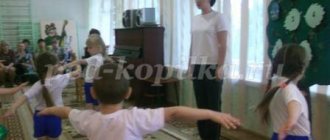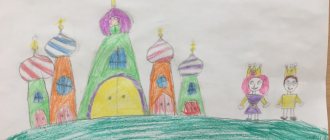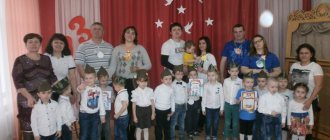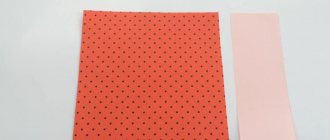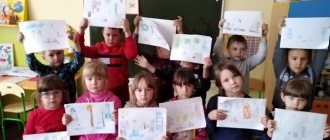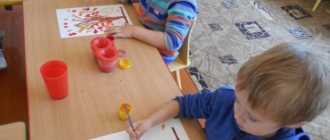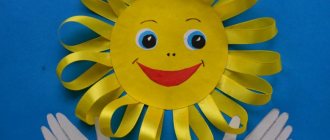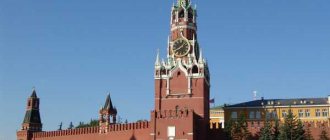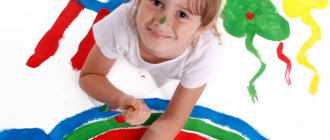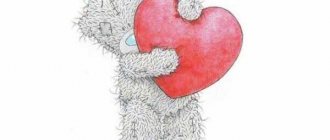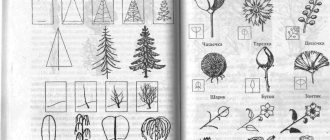Khokhloma. Khokhloma painting for children.
Khokhloma is an ancient Russian folk craft, born in the 17th century in the Nizhny Novgorod region. An old legend tells: once upon a time there lived a man in the Nizhny Novgorod forests, on the banks of a quiet river. We don’t know who he is or where he came from. The man carved wooden cups and spoons and painted them so that they seemed to be made of pure gold. The king found out about this and became angry: “Why don’t I have such a master in my palace?! Give it to me! Immediately!" He tapped his staff, stamped his foot, and sent soldiers to take the craftsman to the palace. The soldiers set off to carry out the royal order, but no matter how much they searched, they could not find the master’s miracle. He went to God knows where, but first he taught local peasants how to make gold utensils. In every hut cups and spoons sparkled with gold.
The village of Khokhloma, Koverninsky district, Nizhny Novgorod region, is considered the birthplace of Khokhloma.
Products for Khokhloma painting, most often dishes and furniture, are made of wood. But before painting on them, the surface is coated with a primer and shiny oil using a special technology. Then this shiny surface is tinned - aluminum powder is rubbed into it with a soft cloth, from which it becomes silvery and very smooth, and after varnishing - golden. The dishes are painted “Khokhloma” with oil paints. Traditional elements of Khokhloma are red juicy rowan and strawberries, flowers and branches. Birds, fish and animals are also often found.
Red, black, gold and green are the colors of Khokhloma. To liven up the pattern, a little white is allowed.
Painting can be “top” - a design is applied to a silver blank in red and black; and “under the background” - first the outline of the ornament is outlined, and then the background is filled with black paint, while the pattern itself is not painted, but remains silver. When varnished, the silver coating will turn golden and look as if it was made of gold. 
Let's practice horse Khokhloma painting? To do this, you need to print a sheet with the pattern or utensils you like. And there - pick up a brush and paints and go!
Grass is a pattern of large and small blades of grass. Pattern elements: sedges, blades of grass, droplets, tendrils, curls and bushes.
Herbal ornament.
Leaf pattern - stems and leaves.
The berry pattern includes the following ornaments: lingonberry, gooseberry, currant, strawberry, rowan, raspberry.
The “gingerbread” ornament is usually painted inside a cup or dish; it is a geometric figure (square or rhombus) decorated with grass, berries, and flowers.
In painting “under the background” the element “curl” is more often used. Curl painting is a rich, lush pattern with round, intricate curls reminiscent of curls. It is not the patterns themselves that are drawn, but the dark background. And the resulting pattern is supplemented with small colored elements (postscripts). This process is much more labor-intensive than horse painting.
Painted items are coated with a special varnish 4-5 times (with intermediate drying after each layer) and finally hardened for 3-4 hours in an oven at a temperature of +150 +160 °C until a golden-colored oil-varnish film is formed. This is how the famous “golden Khokhloma” is obtained.
Varieties of Khokhloma
There are several types of painting in the Khokhloma style. They differ in the method of application and image on wooden objects. Based on the type of application, Khokhloma is divided into the following types:
- background - the design is made on a plain main background, and the ornament is made with gold paint;
- upper – applying a pattern to a ready-made field.
The technique has various painting methods. The most complex technique is applying painting under the background. Initially, the contours of the pattern are applied to the wooden blank, and then some parts begin to be painted over with a black or red background color. After applying the background layer, they begin to make patterns and other complex details.
"Gingerbread"
The simplest method is called “Gingerbread”. In the center of the product there is an image of a geometric figure, for example, a rhombus or a square. Inside it is supplemented with sun, climbing plants, and herbs.
"Grass"
“Travka”, or herbal painting, is applied in abrupt strokes. Leaves are painted with large strokes, blades of grass or dew drops are used with smaller strokes. This element of top painting allows you to fill the entire surface of the product with an openwork pattern. This is one of the most difficult types, which requires patience and special attention from the master.
"Berry"
Another technique called “Berry” is very reminiscent of “Grass”. However, the style looks richer and more decorative than the previous one. It is based on an interweaving of large berries and herbs. As a rule, masters depict strawberries, gooseberries, grapes, and among flowers - chamomile and bell.
"Kudrins"
“Kudrina” is characterized by a certain ornate floral pattern. In this case, the ornament is made with gold paint. The peculiarity of application is to work with a very thin brush.
Materials for painting and stages of preparation for painting
Wooden bases for painting are called “linen”. To make objects from wood, you need not only paint of different shades, but also special purified clay (wapa), which acts as a primer. Drying oil (linseed oil) is also necessary, the correct application of which determines the strength of the pattern.
The next stage is called tinning, which is performed with aluminum powder. It is intensively rubbed into the product, after which the objects acquire shine and are ready for further painting. The paints that the masters use in their work are only oil paints, and the brushes for applying the pattern are mainly squirrel paints.
How and when did Khokhloma originate?
Archives show that beautiful painted dishes were first mentioned in 1659. It was then that a certain boyar named Morozov demanded to collect dishes of various sizes and tin craftsmen from the Trans-Volga lands. In those days, tin was used for gilding. Morozov at that time owned the village of Semenovskoye. In it, as well as in a neighboring village called Khokhloma, a craft for painting wooden products was formed.
The development of such a trade in Rus' was facilitated by the proximity of a large trade route (Volga) and the proximity to the fair - Makaryevskaya. The quality of the dishes was so high that their production was made the main industry for the residents, and the village of Khokhloma became a trading point where unique dishes with unusual designs were sold. After 1916, it was decided to open the School of Artistic Processing of Wooden Products. So Khokhloma received a new round of development.
